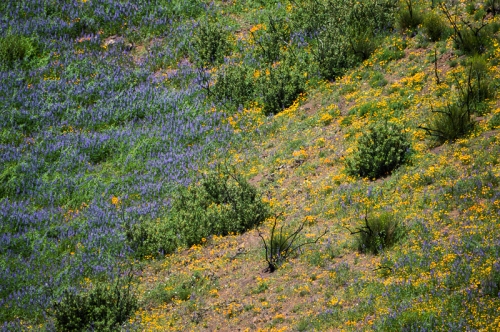Joan Hamilton joined us on March 22nd at The Rotary Nature Center in Oakland. You can read her article on the fire and its after effects on Bay Nature Magazine’s website and other related articles. All with more details and better pictures than my summary below.

Investigating the after effects of the Morgan fire on Mount Diablo was the best article assignment Hamilton said she has ever had. For two years (and another year on now) it brought her to Mount Diablo to witness what happens after a fire here in California. She had been working in Perkin’s Canyon on an audio guide, but now that project was literally toast. But Mount Diablo has a fire interval of 40 to 70 years, so this was pretty much a once-in-a-lifetime opportunity to study the effects of fire in-depth.
“Nature is pulling back the curtain. Let the play begin. We’ll see who shows up and gives the best performance.”
— Nomad Ecology botanist Heath Bartosh
The fire started on September 8th 2013 when a young man doing target practice hit a rock which sparked a grass fire which then lit a grey pine and then from then took off through the mountain.
Joan visited a few days after the fire, and the ground was still smoking, oak leaves were toasted, meadows were black, and the chaparral burnt. They found themselves being bit on the necks and hands by beetles a species that firefighters know well. The beetles only show up after fire, looking to lay their eggs in the smoldering trees. Apparently, way back mid-20th-century, used to show up at Cal games, drawn to cigarette smoke.
The fire had gone clear to the top of the mountain. Fire fighters had dumped lots of fire retardant to keep it from going over the summit, but they spent much of their effort (hundreds of firefighters, 6 planes, and 25 bulldozers) protecting homes and communities outside the park. The state park wanted the fire to take its natural course inside the park.
On first look, it seemed like it might have been too much. Some oaks had burned down to the roots, and slopes seemed like they might erode away from lack of vegetation. But even that first visit they noticed that rodents were already at work disturbing the burnt soil.
By the 9th day, plants were poking out: grass, vetch, mustard and others. At 6 weeks, shrubs were beginning to resprout at their base. By April, there was skullcap, baccarus, deerweed, and a fire follower called whispering bells (because of the sounds it makes when it is dried up).
Researchers Heath Bartosh and Brian Peterson decided to do a study of this “fleeting abundance” to see what wildflowers would come up three years running after a fire. They set up a series of 1m square research areas across the mountain listing every species and the % of cover. They did this out of curiosity not because someone was paying them.
What they found were 28 opportunists — species like the Mt. Diablo globe lilly — which were are commonly found there, but came on strong because of the extra space and sunlight the fire afforded them. But there were also 17 fire followers like the whispering bells, and golden ear drops. The species that everyone wanted to see, the flame poppy, was elusive at first, but eventually showed itself.
The second year made the work of this research difficult as a native morning glory flourished (they referred to it as trip vine). There was also some nice surprises: Kellog’s climbing snapdragon which hadn’t been seen 80 years, and the sleepy catchfly which hadn’t been seen in 125 years. Bulb plants went crazy: mariposa lilies, fremont star lily. California poppy, Mt Diablo jewel fire were both abundant.
The burnt chaparral was where the diversity seemed richest.
There were other researchers out there as well. Mandi McElroy got a grant for remote cameras and began a study of mammals on the mountain. The cameras have so far caught the obvious ones: black tailed deer, wild pigs, and coyote. But it will take a while longer to sort out the effect on smaller animals. The pigs seem to be doing well from what they have seen so far.
Entomologist Kip Will began a 5 year study of arthropods in the area. Setting out to trap insects on land in the air, day and night, to be as an detailed as possible to get baseline data. So far, beetles are two times as numerous in burned areas, and 16 new species of moth have been recorded on the mountain including the sphinx moth with a whopping 4” wingspan.
Lindsey Hendricks began looking at the effects of the fire on the previously dominant Chamise, looking at growing chamise in different fire affected soils. It turns out the Chamise likes it hot. It only sprouted in soil that was moderately to severely burned soil. In unburned soil the enormous numbers of seeds that chamise produces simply did not germinate.
At the tree level, the oaks came back. Only small handful did not survive the fire. In some cases, the trees were resprouting from the trunk and biggest branches. A lot of big grey pines on the other hand did not make it… Their chemical makeup is such that they burn up quicker and easier than other pines having a chemical similar to gasoline. But they are coming back from seed.
There were few problems with invasives, even in areas where they thought it was more at risk (the bulldozed zones in particular), erosion turned out to not be a problem because the root systems of many plants were still intact holding the soil together (and until this year we had below level rainfall probably did not hurt).
All in all seeing the mountain change from year to year was an amazing opportunity for Hamilton. She had a few suggestions for places to go if you want to check out the burn sites:
- The North Peak Trail from Devil’s Elbow down to Prospectors Gap. From there, you can either head up to North Peak or down to the park boundary along the Prospectors Gap fire road.
- Green Ranch Road from Oak Knoll picnic area down to Rhine Canyon and Frog Pond.
- Perkins Canyon on Ray Morgan Road and Perkins Canyon Trail.





